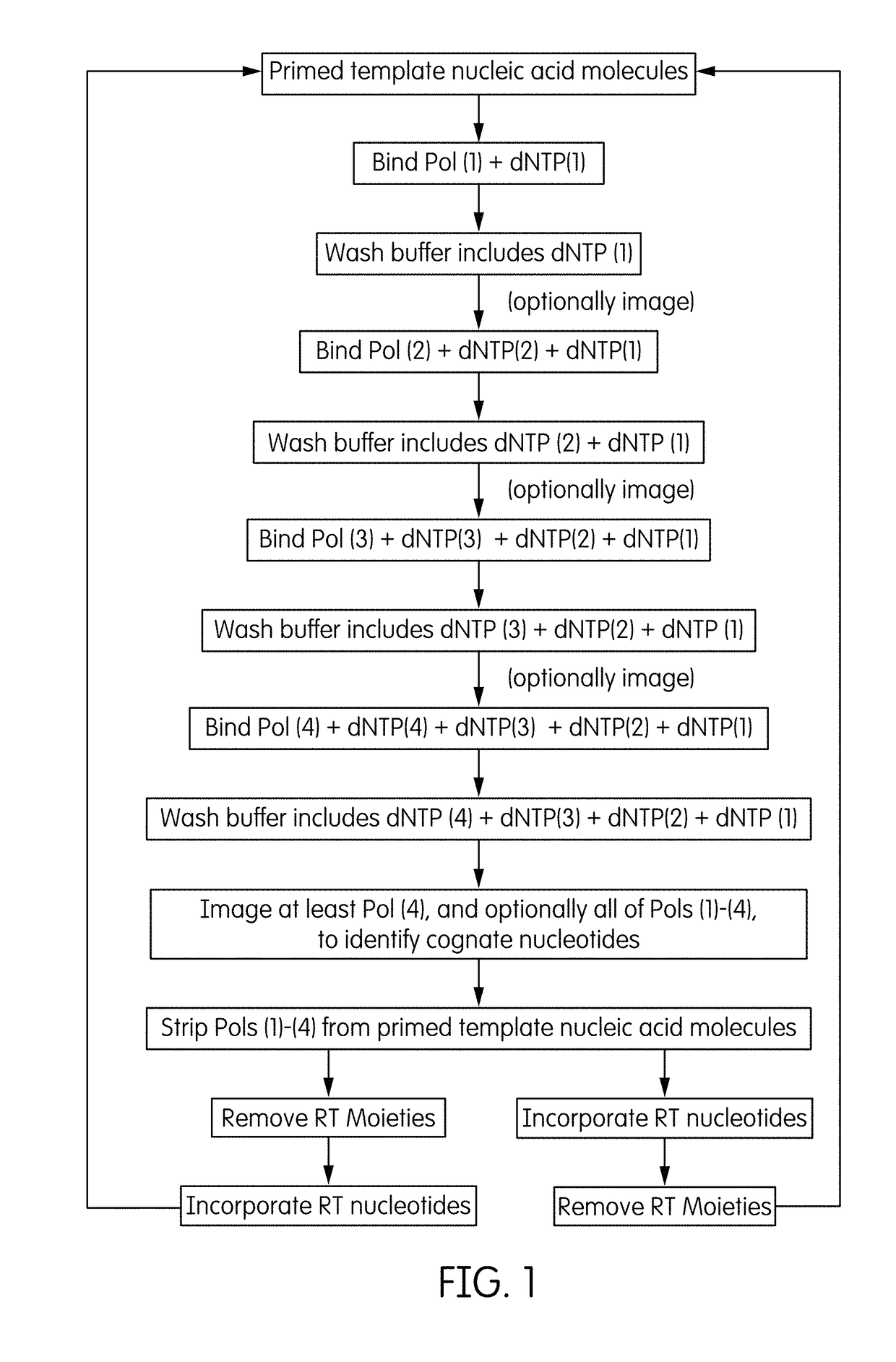Method and system employing distinguishable polymerases for detecting ternary complexes and identifying cognate nucleotides
- Summary
- Abstract
- Description
- Claims
- Application Information
AI Technical Summary
Benefits of technology
Problems solved by technology
Method used
Image
Examples
example 1
Stabilizing Ternary Complexes Against Polymerase Exchange
[0229]A FORTEBIO® (Menlo Park, Calif.) Octet instrument employing biolayer interferometry to measure binding reactions at the surface of a fiber optic tip was used in a multiwell plate format to assess formation and stability of ternary complexes in the presence of different non-catalytic metal ions. Template nucleic acid strands biotinylated at their 5′-ends were used to immobilize the primed template nucleic acid onto fiber optic tips functionalized with streptavidin (SA) according to standard procedures. Tips were washed in a Tris-buffered solution containing 200 mM KCl, 160 mM potassium glutamate, and 0.01% Tween-20 before commencing the cycling protocol. Binding reactions conducted using 2 mM of the test metal ion (i.e., 2 mM of the metal salt) were carried out in serial fashion using examination buffers that contained Tris-HCl (pH 8.0), 220 mM KCl, 160 mM potassium glutamate, 0.01% Tween-20, 1 mM β-mercaptoethanol, 100 μ...
example 2
Enhancing Polymerase Discrimination Between Cognate and Non-Cognate Nucleotides in the Presence of an Agent that Stabilized Ternary Complexes
[0232]Materials and methods used in the procedure were as follows. The FORTEBIO® OCTET® instrument employing biolayer interferometry was used to measure binding reactions at the surface of a fiber optic tip in a multiwell plate format to investigate differential formation of binary and ternary complexes. Template strands biotinylated at their 5′-ends were used to immobilize the primed template nucleic acid onto fiber optic tips functionalized with streptavidin (SA) according to standard procedures. The next correct nucleotide for the biotinylated template DNA was dCTP (with dGTP being used as the model incorrect nucleotide). Tips were first equilibrated in a Tris-buffered solution containing 30 mM Tris-HCl (pH 8.0), and 0.1 mM EDTA before commencing the cycling protocol. Independent binding reactions for the two test nucleotides (i.e., cognate ...
example 3
Rapid Identification of Cognate Nucleotide
[0240]Flow cells were prepared using magnetic 1 μM microbeads displaying synthetic primed template nucleic acids of known sequence. Briefly, streptavidin-coated MyOne Cl magnetic beads (ThermoFisher Scientific; Waltham, Mass.) were functionalized with a TCO-PEG4-NHS (transcyclooctene-polyethylene glycol-N-hydroxysuccinimide) moiety that reacts with free amine moieties on the streptavidin. The TCO-modified beads were then incubated in a solution containing the desired primed template nucleic acid molecule at a concentration of 100 nM. Here two different primed template nucleic acids were employed on different beads. The next correct nucleotide for the primed template disposed on one bead type (the “C2” bead) was dCTP. The next correct nucleotide for the primed template disposed on the other bead type (the “A2” bead) was dATP. The beads were next introduced into a flow cell constructed with an aminosilane-coated coverslip that had been modifie...
PUM
| Property | Measurement | Unit |
|---|---|---|
| Volume | aaaaa | aaaaa |
Abstract
Description
Claims
Application Information
 Login to View More
Login to View More - R&D
- Intellectual Property
- Life Sciences
- Materials
- Tech Scout
- Unparalleled Data Quality
- Higher Quality Content
- 60% Fewer Hallucinations
Browse by: Latest US Patents, China's latest patents, Technical Efficacy Thesaurus, Application Domain, Technology Topic, Popular Technical Reports.
© 2025 PatSnap. All rights reserved.Legal|Privacy policy|Modern Slavery Act Transparency Statement|Sitemap|About US| Contact US: help@patsnap.com



